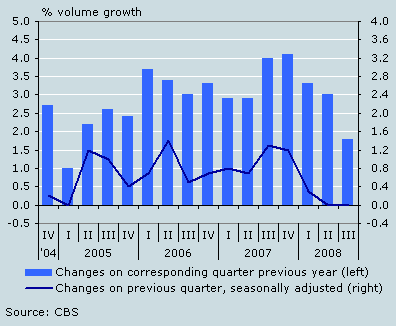Substantial economic decline

The picture of the economic situation at the end of January was far worse than at the end of December. This is mainly the result of lower production and lower exports. The heart of the indicators in the Business Cycle Tracer is located in the recession stage.
Dutch economic growth is slowing down. In the third quarter, economic growth was 1.8 percent compared with one year previously. Growth was almost reduced by half compared with the first six months of 2008. The Dutch economy showed zero growth in the third quarter compared with the second quarter. This is the second time in a row that there was no quarter-on-quarter growth.
In November, manufacturing production was over 6 percent down on the same month one year previously. It was the fifth decrease in a row. Export volume was nearly 6 percent down. Consumption expenditure decreased by 0.4 percent compared with November 2007.
Consumer confidence dropped slightly in January. This indicator stood at -30 in January, compared to -28 in December 2008. Confidence among manufacturers improved marginally. However, producer confidence was still exceptionally low: -19.7. The mood among business services providers deteriorated further.
In December, capital market interest averaged 3.7 percent, i.e. nearly 0.3 of a percentage point down on November. The Dutch inflation rate dropped from 2.3 percent in November to 1.9 percent in December. Selling prices in the manufacturing industry were over 7 percent down on December 2007.
In the period October-December, seasonally adjusted unemployment was slightly higher than in the period September-November. Job growth in the third quarter of 2008 was less vigorous than in the first six months. The number of job vacancies remained high, the number of hours worked in temp jobs decreased marginally.
Gross domestic product (GDP)
